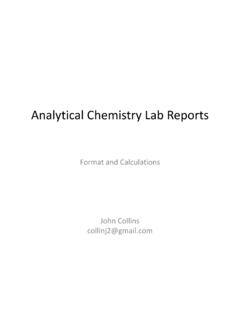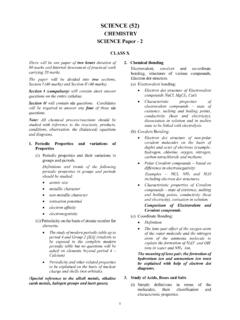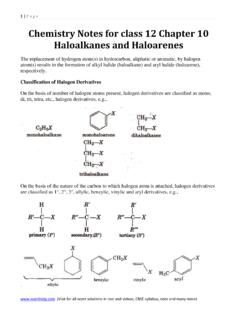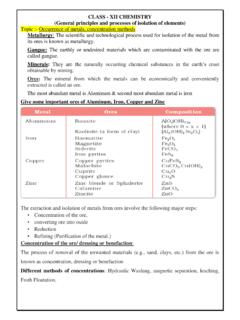Transcription of CHEMISTRY (862)
1 1 CHEMISTRY (862) class XII There will be two papers in the subject: Paper I: Theory - 3 hours .. 70 marks Paper II: Practical: 3 hours .. 15 marks Project Work .. 10 marks Practical File .. 5 marks PAPER I (THEORY) - 70 Marks There will be no overall choice in the paper. Candidates will be required to answer all questions. Internal choice will be available in two questions of 2 marks each, two questions of 3 marks each and all the three questions of 5 marks each. UNIT TOTAL WEIGHTAGE 1. Solid State Physical CHEMISTRY 25 Marks 2. Solutions 3.
2 Electrochemistry 4. Chemical Kinetics 5. Surface CHEMISTRY 6. General Principles and Processes of Isolation of Elements Inorganic CHEMISTRY 20 Marks 7. p -Block Elements 8. d -and f -Block Elements 9. Coordination Compounds 10. Haloalkanes and Haloarenes Organic CHEMISTRY 25 Marks 11. Alcohols, Phenols and Ethers 12. Aldehydes, Ketones and Carboxylic Acids 13. Organic Compounds containing Nitrogen 14. Biomolecules 15. CHEMISTRY in Everyday Life TOTAL 70 Marks 2 PAPER I THEORY 70 Marks 1. Solid State Solids: their classification based on different binding forces such as: ionic, covalent molecular; amorphous and crystalline solids (difference), metals.
3 Type of unit cell in two dimensional and three-dimensional lattices, number of atoms per unit cell (all types). Calculation of density of unit cell, packing in solids, packing efficiency, point defects and magnetic properties. (i) Crystalline and amorphous solids. (ii) Definition of crystal lattice, unit cell; types of unit cell (scc, fcc, bcc); calculation of the number of atoms per unit cell; relationship between radius, edge length and nearest neighbour distance. Calculation of density of unit cell, formula of the compound numericals based on it; packing in 3 D, packing fraction in scc, fcc, bcc with derivation.
4 (iii) Characteristics of crystalline solids; ionic (NaCl), metallic (Cu), atomic (diamond and graphite). (iv) Point defects: Stoichiometric, non- stoichiometric and impurity defects (F- centres). (v) Magnetic properties: diamagnetic and paramagnetic. 2. Solutions Study of concentration of solutions of solids in liquids, liquid in liquid, solubility of gases in liquids, Colligative properties - Raoult's law of relative lowering of vapour pressure, elevation of boiling point.
5 Depression of freezing point, osmotic pressure. Use of colligative properties in determining molecular masses of solutes. Normality, molality, molarity, mole fraction as measures of concentration.
6 Definition of the above with examples. Simple problems based on the above. (i) Solubility of gases in liquids Henry s Law. (ii) Raoult s Law for volatile solutes and non-volatile solutes, ideal solution, non-ideal solution. Azeotropic mixtures definition and types. (iii) Colligative properties definition and examples, and its use in determination of molecular mass. (a) Relative lowering of vapour pressure: Definition and mathematical expression of Raoult s Law. Determination of relative molecular mass by measurement of lowering of vapour pressure.
7 (b) Depression in freezing point: molal depression constant (cryoscopic constant) definition and mathematical expression (derivation included). (c) Elevation in boiling point method: molal elevation constant (ebullioscopic constant) definition and mathematical expression (derivation included). (d) Osmotic pressure: definition and explanation. Natural and chemical semipermeable membranes, reverse osmosis, isotonic, hypotonic and hypertonic solutions. Comparison between diffusion and osmosis.
8 Application of osmotic pressure in the determination of relative molecular mass. Numerical problems based on all the above methods. Experimental details not required. 3. Electrochemistry Electrolytic and electrochemical cells. Redox reactions in electrochemical cells. Electromotive Force (emf) of a cell, standard electrode potential, Nernst equation and its application to chemical cells. Relation between Gibbs energy change and emf of a cell. Conductance in electrolytic solutions, specific, equivalent and molar conductivity, variations of conductivity with concentration, Kohlrausch's Law of electrolysis and Faraday s Laws of electrolysis.
9 (i) Electrochemical cells: introduction, redox reactions (principl e of oxidation and reduction in a cell). 3 (ii) Galvanic cells - introduction; representation, principle ox idation reduction. Mechanism of production of electric current in a galvanic cell. (iii) Measurement of potential. Single electrode potentials. Standard hydrogen electrode - definition, preparation, application and limitations. Standard electrode potential (Eo) - Measurement of standard electrode potential of Zn ++ / Zn, Cu ++ / Cu, half cell (using standard hydrogen electrode).
10 Cell notation representation. Factors affecting electrode potential with explanation - main emphasis on the temperature, concentration and nature of the electrode. (iv) Electrochemical series. Its explanation on the basis of standard reduction potential. Prediction of the feasibility of a reaction. (v) Nernst equation and correlation with the free energy of the reaction with suitable examples. Prediction of spontaneity of a reaction based on the cell emf. Numericals on standard electrode potential of half-cells, cell emf, relationship between free energy and equilibrium constant, standard electrode potential and free energy.
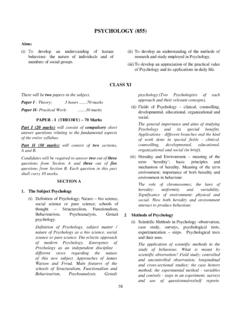
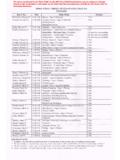

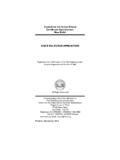
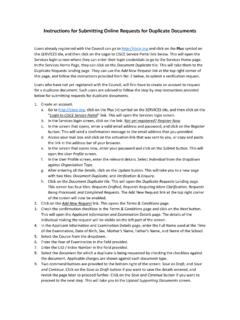
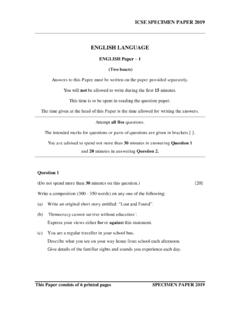
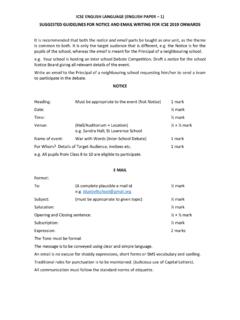
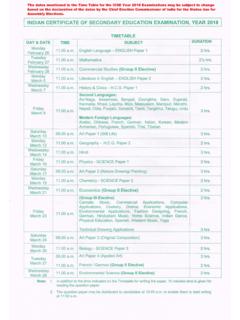
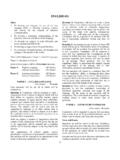
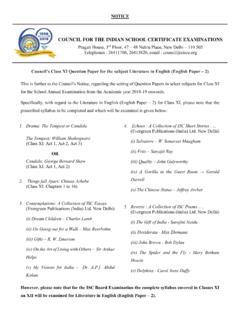
![[CLASS XII CHEMISTRY PRACTICALS] - Saint John's Senior ...](/cache/preview/8/e/c/c/7/0/2/b/thumb-8ecc702b441a6099d9810dbf9f2c3c2f.jpg)

